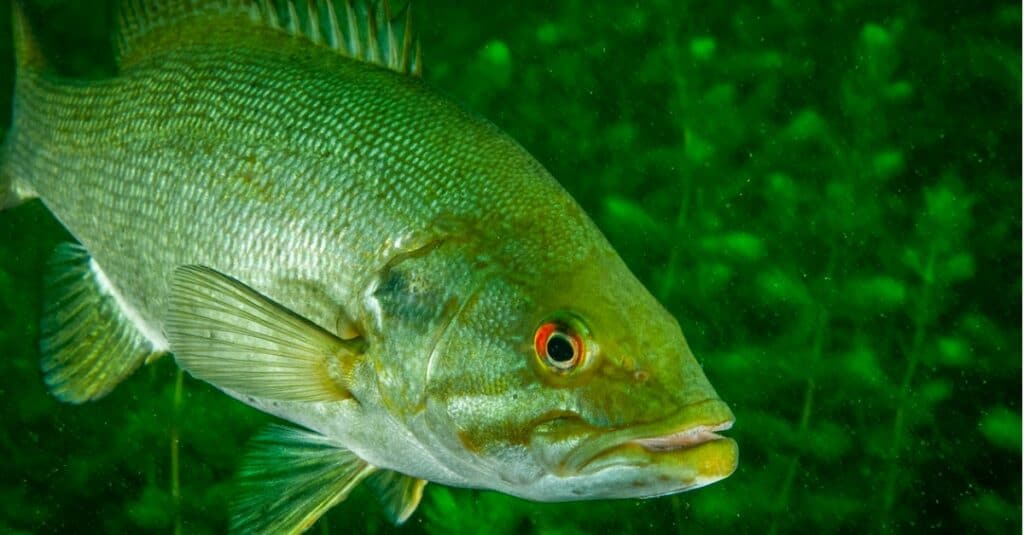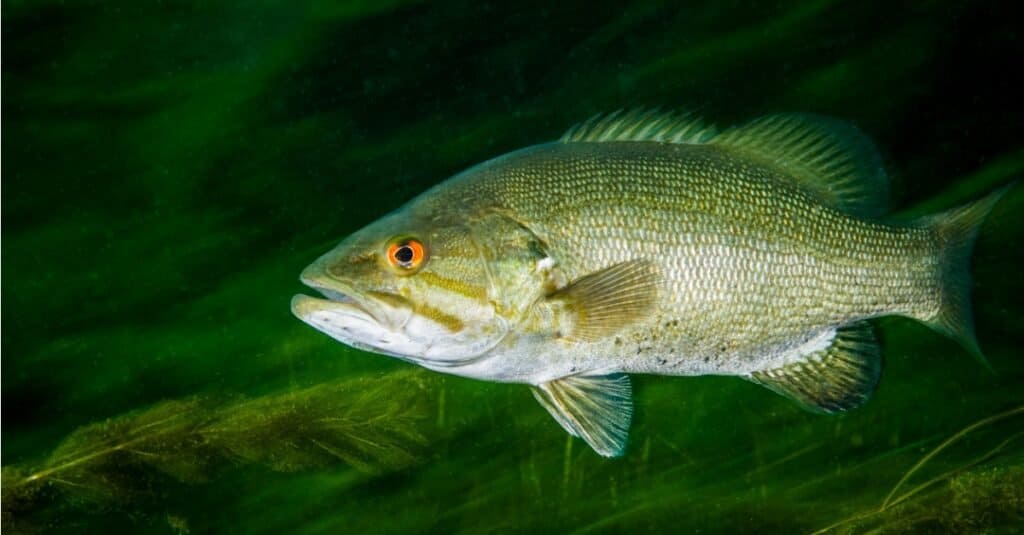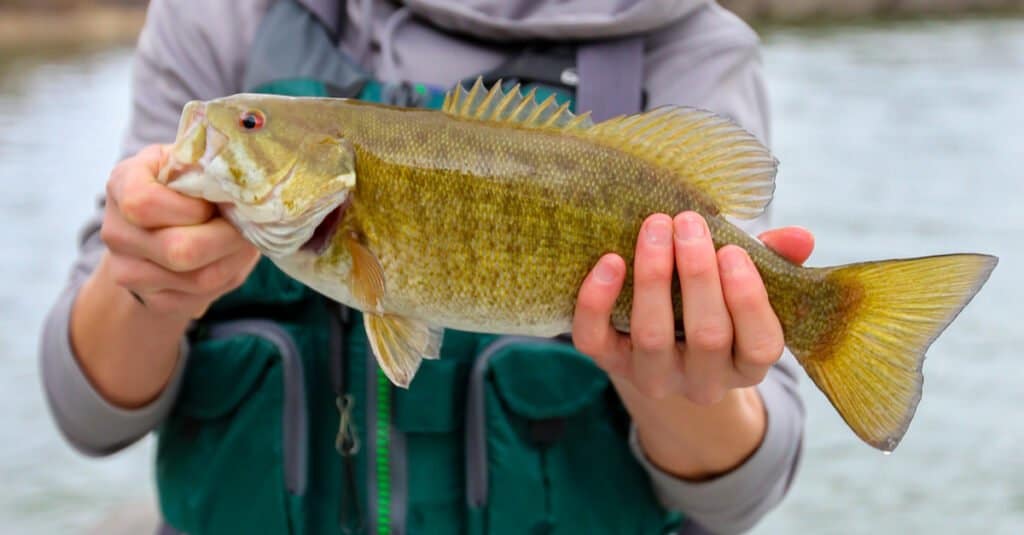Are you planning to fish for some smallmouth bass and wondering what they eat? Or maybe you’re a fish enthusiast who enjoys discovering incredible facts daily! Whatever your reason, we can relate! That’s why we’re now discussing a smallmouth bass’s diet. After all, this fish species is one of the most popular among anglers!
What Is a Smallmouth Bass?

Smallmouth bass is also called bronzeback, brownie, bronze bass, bareback bass, brown bass, and smallie.
©iStock.com/RLSPHOTO
The smallmouth bass is a freshwater fish called Micropterus dolomieu. It is part of the Centrarchidae family of sunfish. This fish is native to the Saint-Lawrence River-Great Lakes system, the upper and middle Mississippi River basin, and the Hudson Bay basin. It is one of the most popular game fish species among anglers.
Smallmouth bass is also called bronzeback, brownie, bronze bass, bareback bass, brown bass, and smallie. It lives in rivers and streams, as well as in rocky areas and sandy bottoms of reservoirs and lakes. Compared to largemouth bass, smallmouth bass prefers cooler water, so it’s primarily found in deeper, fast-moving waters. However, when the water temperature drops below 60 degrees Fahrenheit, smallmouth bass will go deeper and enter a semi-hibernation state.
Smallmouth bass fish have slender bodies. Their color patterns vary depending on the fish’s age, habitat, diet, and spawning cycle. Their scales may be anything from golden-olive to dark brown dorsally. Ventrally, they are yellowish-white. These fish have brown horizontal bars on their heads and brown vertical bars along their bodies. This color pattern makes it easy for them to camouflage, hunt, and ambush prey. Smallmouth bass have two dorsal fins and a shallow interdorsal notch.
As their name suggests, smallmouth bass have small mouths, well-proportioned with their heads. In comparison, largemouth bass have very large mouths with jaws extending well above their eyelines.
Male smallmouth bass weighs 2 pounds, while females weigh 3 to 6 pounds. The largest smallmouth bass ever recorded measured 27 inches long and weighed 12 pounds.
There are two smallmouth subspecies: the Northern smallmouth bass, called Micropterus dolomieui dolomieui, and the Neosho smallmouth bass, called Micropterus dolomieui velox.
What Do Smallmouth Bass Eat?

bass eat crayfish, lizards, frogs, sculpins, minnows, threadfin shad, smaller fish, insects, and tadpoles.
©iStock.com/RLSPHOTO
Smallmouth bass are carnivorous. What they eat is heavily influenced by where they live, their age and size, the season, and the water and air temperature. They are often regarded as opportunistic feeders that will eat anything they can find, as long as it’s small enough to catch and swallow.
Smallmouth bass eat crayfish, lizards, frogs, sculpins, minnows, threadfin shad, smaller fish, insects, and tadpoles. Juvenile smallmouth bass eats zooplankton, crustaceans, and small aquatic insects.
These fish are most active during the daytime, at dawn, and dusk. In warm seasons, they feed during the night too. To catch the prey, a smallmouth bass lures it into open water, away from sheltered areas, where it kills and eats it.
A study based on the smallmouth bass population in Lake Erie’s eastern basin near Buffalo, NY, shows that this species loves round gobies. Crayfish seemed to be smallmouth bass’ favorite food, and half of their diet in this specific region consisted of crayfish. Once round gobies invaded the lake, smallmouth bass rapidly gave up on crayfish and switched to round gobies.
In the end, round gobies represented 75% of their diet! This indicates that smallmouth bass has the potential to control the invasive round goby species.
A List of Foods Smallmouth Bass Eat
Here’s a list of foods smallmouth bass eat:
- Crayfish
- Round goby
- Lizard
- Frog
- Minnow
- Sculpin
- Small fish
- Insect
- Tadpole
- Threadfin shad
Do Smallmouth Bass Eat Mice?
While this may sound odd, and it definitely doesn’t happen often, smallmouth bass can totally eat mice if they fall into the water. They’ll delight in them!
In fact, if they’re unlucky enough, mice can fall prey to many other aquatic animals besides smallmouth bass, including brook trout or northern pike.
What Threats Do Smallmouth Bass Face?

Smallmouth bass are highly affected by human action.
©CSNafzger/Shutterstock.com
Although smallmouth bass are fierce predators, they can be killed by other larger fish like muskellunge, northern pike, and larger bass.
Despite not having many predators beneath the water’s surface, they’re highly affected by human action. For example, because they’re extremely sensitive to pollution, they’ll have to leave their homes at the slightest sign that the water isn’t favorable enough.
Moreover, studies showed that, in some cases, synthetic hormones that got into their habitats changed their sexual organs. For example, there are smallmouth bass whose sexual organs oscillate between male and female.
What Is the Best Bait for Smallmouth Bass?
Before choosing a bait for smallmouth bass, you’ll need to assess the situation:
- Where do smallmouth bass live?
- What do smallmouth bass eat there?
- How do smallmouth bass behave in that specific habitat?
- What season are you fishing in, and how cold is the water?
- Will you fish during the day or the night?
The answers to these questions may change your whole strategy. For example, if you’re fishing during autumn and the water is cold, you may want to use smaller lures like small spinners or hair jigs. When the water is warm, you can use spinnerbaits and soft plastic tubes.
Generally, popular smallmouth bass baits include ned rigs, jerkbaits, topwater baits, spinnerbaits, blade baits, small soft plastics, jigs, and crankbaits. Some anglers suggest fishing with different flies.
For many years, spinning or fly tackle has been among North America’s most popular smallmouth angling tools for river fishing.
Up Next:
- What Do Bass Eat?
- Smallmouth vs. Largemouth Bass: What’s the Difference?
- Discover the Largest Largemouth Bass Ever Caught in Wisconsin
The photo featured at the top of this post is © iStock.com/RLSPHOTO
Sources
- Pond Informer, Available here: https://pondinformer.com/smallmouth-bass-micropterus-dolomieu/
- The Ohio State University, Available here: https://u.osu.edu/enrfishtax/2019/12/11/lake-erie-smallmouth-bass-diet/
- Chesapeake Bay Program, Available here: https://www.chesapeakebay.net/discover/field-guide/entry/smallmouth-bass
- Lake Scientist, Available here: https://www.lakescientist.com/lake-facts/fish/smallmouth-bass/
Thank you for reading! Have some feedback for us? Contact the AZ Animals editorial team.






